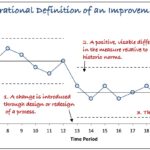By David M. Williams, Ph.D. “What is YOUR definition of ‘improvement’?” she asked. The leadership team just finished reviewing the improvement efforts from last year. Teams summarized their projects and shared reflections on key learnings and barriers. The team worked together all year, and their investment of time, energy, and desire was evident. Enthusiasm was […]

